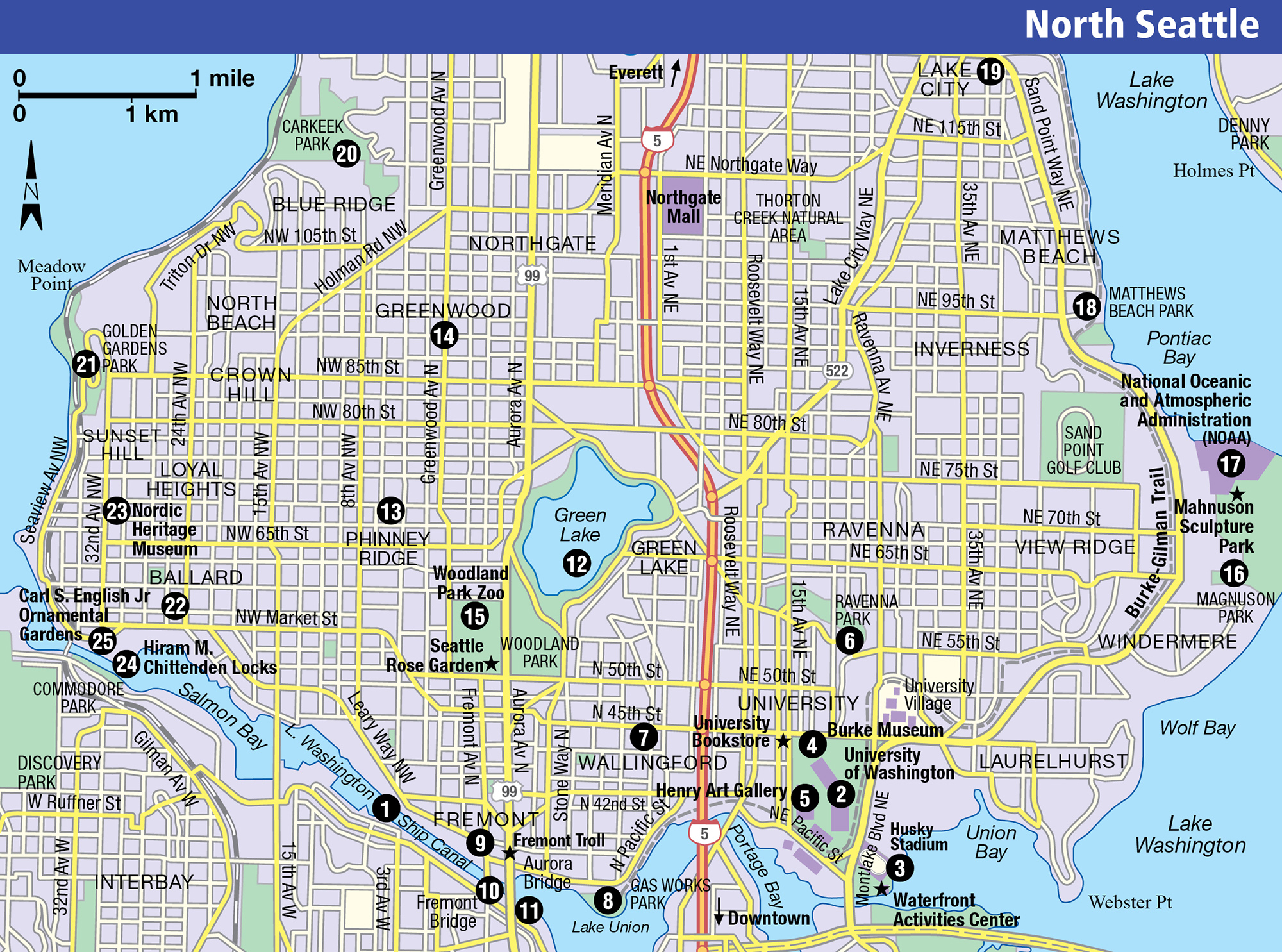Maps and Listings
The 8-mile (13km) -long Lake Washington Ship Canal 1 [map] separates the northern neighborhoods of Seattle from the city center. Completed in 1917, the canal winds through the Ballard, Fremont, Wallingford, and University districts linking salty Puget Sound with the fresh waters of lakes Union and Washington. A series of locks raise and lower ships making the transit. Six bridges cross the canal, leading into a cluster of neighborhoods born as independent townships in the 19th century that retain distinctly individual characteristics.

Along the Lake Washington Ship Canal.
Tim Thompson/Apa Publications
The University District
The Burke-Gilman Trail is a 27-mile (43.5km) biking and walking route, beginning in Ballard, swinging along Lake Union past Gas Works Park, winding through the University of Washington campus before coursing north on the left bank of Lake Washington (stay on the trail to continue all the way to Marymoor Park in Redmond).

Gas Works Park.
nathaniel gonzales/APA publication
The University District is an eclectic commercial center thriving on the cultural, educational and athletic amenities afforded by the University of Washington. University Way Northeast, affectionately called ‘the Ave’ by locals, is a busy strip of shops, theaters, newsstands, bookstores, pubs, and eateries. Some Seattleites treat this animated district with caution, as an increasing number of panhandlers, rebellious young people, and homeless bring with them a sometimes shadowy subculture. But the diversity of the community, made up of students, businesspeople, academics, and vagrants, certainly has a verve and vitality. The University Bookstore (4326 University Way NE; tel: 206-634 3400), a stalwart of ‘the Ave’ since 1925, has a huge selection of contemporary fiction as well as textbooks, school and art supplies, and T-shirts.
Tip
A plethora of cultural events takes place at the University of Washington throughout the year, from classical concerts to big-name author readings to social commentators. Events are announced on the excellent university radio station KUOW 94.9FM, in the local newspapers, and on the Campus Events Calendar: www.washington.edu/visit/events.
University of Washington
A few blocks to the east is the 640-acre (260-hectare) University of Washington 2 [map] campus itself. Almost 50,000 students and more than 40,000 staff come here to the state’s finest public university, best known for its medical and law schools, and for fine research facilities. Pick up a self-guided walking tour brochure from the Visitors’ Information Center (022 Odegaard; tel: 206-543 9198; www.uw.edu/visit).
Much of the original campus was designed by the Olmsted family, famous for New York’s Central Park. Drumheller Fountain sits at the top of the Rainier Vista Mall, the gateway to the Gothic-style Quad, where in April rows of cherry trees burst into pink or white blossoms.

Cherry blossom at the University of Washington’s quad.
Bigstock
The addition of the Allen Library, made possible by a $10-million donation from Paul Allen, co-founder of Microsoft, expanded by 40 percent the capacity of the Gothic-style Suzzallo Library, which was opened in 1927 and dubbed the soul of the university by then-president Henry Suzzallo. The red-tiled plaza adjoining Suzzallo is known as Red Square. On summer evenings at the Theodor Jacobsen Observatory (tel: 206-685 7856; www.astro.washington.edu.groups/observatory; variable hours; free) visitors can gaze at the heavens through one of the observatory’s telescopes.
Husky Stadium 3 [map] is in the southeast corner of the campus. It is one of the largest in the Pacific Northwest, with a capacity for 72,000 spectators to watch its extremely popular football games. New renovations to the stadium include seismic reinforcements, new seating, and a new concourse. Adjacent to Husky Stadium, work is underway on the Sound Transit light-rail station, which is scheduled to be completed around 2016. The University Link will connect riders with Capitol Hill and Downtown. Just below the stadium, on Union Bay, weekend water warriors rent rowboats or canoes at the UW Waterfront Activities Center (open daily 10am–6pm, until 9pm in summer; tel: 206-543 9433), while others bring their own beer and boats.

Native American carving outside the Burke Memorial Washington State Museum.
Getty Images
Burke Museum of Natural History and Culture 4 [map]
Address: corner of 17th Avenue NE and NE 45th Street, www.burkemuseum.org
Tel: 206-543 5590
Opening Hrs: daily 10am–5pm, first Thur of each month until 8pm
Entrance Fee: charge
Transportation: bus 25, 49, or 70
The Burke is the Northwest’s premier museum of natural and cultural history. It has the only dinosaur skeletons in the Pacific Northwest, as well as the region’s most comprehensive collection of Native art from the Northwest Coastal tribes.
The impressive anthropology, geology, and zoology collections when combined total more than 3 million specimens and artifacts. The museum has a ‘walk-through’ volcano, in addition to two permanent exhibits. One illustrates 500 million years of regional history, while the other highlights Pacific Rim cultures.
Henry Art Gallery 5 [map]
Address: 15th Avenue NE and NE 41st Street, www.henryart.org
Tel: 206-543 2280
Opening Hrs: Wed, Sat–Sun 11am–4pm, Thu–Fri 11am–9pm
Entrance Fee: charge
Transportation: bus 25, 49, or 70
Not far from the Burke, this gallery has 46,000 sq ft (4,300 sq meters) of exhibit space to show its 24,000 pieces of 19th- to 21st-century art, including Japanese ceramics and the American and European painting collection of Horace C. Henry, a real-estate and railroad magnate for whom the museum was named in 1927.
Ravenna Park
Seattle is young enough that residents still wistfully imagine the land as it was over a century ago – a wilderness of virgin forests and crystal waterways. Just north of the University of Washington is lush Ravenna Park 6 [map], an unspoiled, deep, and wooded gorge far from the cosmopolitan life. Standing in silence next to a towering tree or a spill of green fern, it is not hard to imagine early settlers meeting a grizzly bear on the track or gathering herbs for healing. Both the town and the park were named Ravenna after the city on Italy’s northern coast, which also stood on the edge of an ancient forest.
Wallingford
West of the University District, Wallingford 7 [map]
has a residential history steeped in memories of the sounds and stench that arose from the gasworks at the bottom of the neighborhood.
The district attracted working-class people who took a special pride in their schools. The earliest school in the area, Latona, was founded in 1889. The Home of the Good Shepherd, a girls’ orphanage started in 1906 by the Sisters of Our Lady of Charity, is now a cultural and community center. Many of the neighborhood’s old houses are elegant showpieces today. The historic 1904 Interlake Public School at the corner of 45th and Wallingford was converted into a mixed-use complex in 1983. Now Wallingford Center, it has restaurants and shops, with apartments above. Shops and cafés line 45th Avenue for several blocks, and you can find bakeries, bars, coffee- and teashops, as well as little specialty stores. The street even has two small movie theaters.

Machineries at Gas Works Park.
nathaniel gonzales/APA publication
Address: 2101 N Northlake Way, www.seattle.gov/parks
Tel: 206-684 4075
Opening Hrs: daily 6am–10pm
Entrance Fee: free
Transportation: bus 26
Hulking specters of a bygone age dominate Gas Works Park 8 [map], situated on a southerly knob of land jutting into Lake Union and the front door to North Seattle. The Seattle Gas Light Company began to produce heating and lighting gas in this refinery on the 20-acre (8-hectare) knoll in 1906, fueling a rapidly growing city while earning a reputation as a filthy, foul-smelling killer of vegetation and wildlife. The plant closed its valves for good in 1956.
When the site was proposed as a park in the early 1960s, the city council hired landscape architect Richard Haag to create a lush, arboretum-type park. Instead, Haag submitted a plan incorporating much of the old gas plant. His design – with the rusting hulks of the gasworks in the middle of an undulating lawn – triumphed after a storm of controversy from those wishing for a more traditional park.
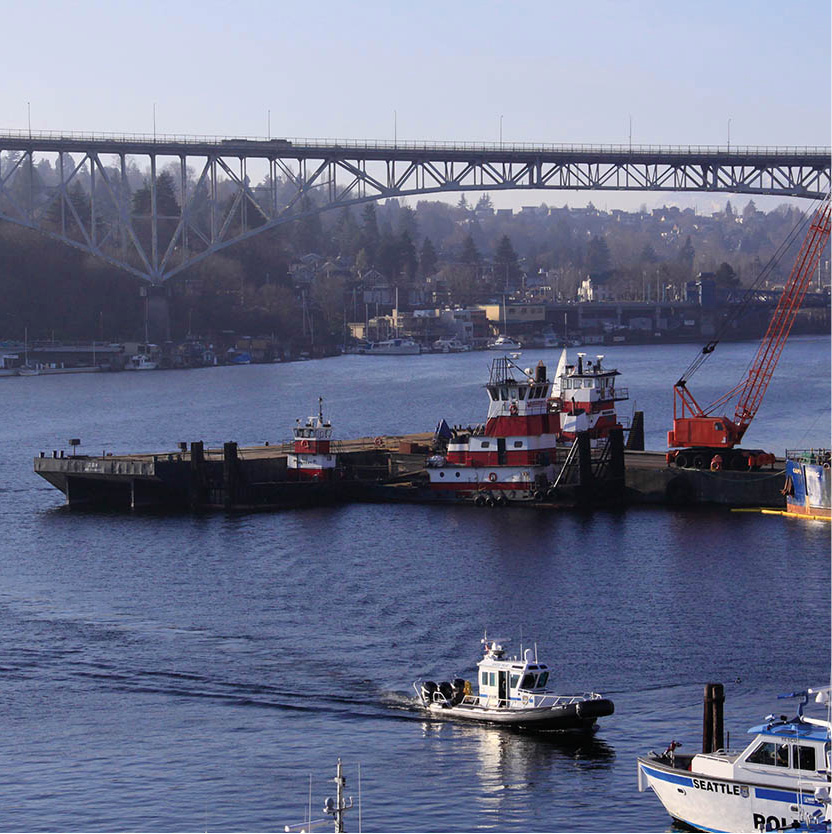
View from Gas Works Park.
nathaniel gonzales/APA publication
Kites fly high over the park’s Grand Mound, a grassy hill built west of the park’s core from abandoned industrial waste. Picnickers and joggers share the space along an incline, and at the crown, visitors admire a mosaic astrological sun and moon dial. The crest offers a great panorama of inner Seattle – Downtown, Queen Anne Hill, the Aurora Bridge (where Highway 99 crosses the Lake Washington Ship Canal) to the west, and Capitol Hill to the east.

Taking in the view of the skyline.
nathaniel gonzales/APA publication
Fremont 9 [map]
No bridge in the state opens more often than the Fremont Bridge ) [map], which was constructed in 1917 over the Lake Washington Ship Canal. You can watch boats go under the blue and orange drawbridge from a peaceful overlook at the Fremont Canal Park, a walkway on the north side of the waterway that features outdoor public art. Just east of the bridge on the north side is the headquarters of Adobe Software.
Fremont, strategically located at the northwest corner of Lake Union, was once a busy stop on the 1880s Burke-Gilman’s SLS&E Railway, which carried lumber, coal, and passengers between Downtown and Ballard.
During Prohibition, Fremont’s thriving taverns and hotel salons were closed, though the basement speakeasies flourished in spite of the frequent police raids. The Aurora Bridge ! [map] opened in 1932, bypassing Fremont.
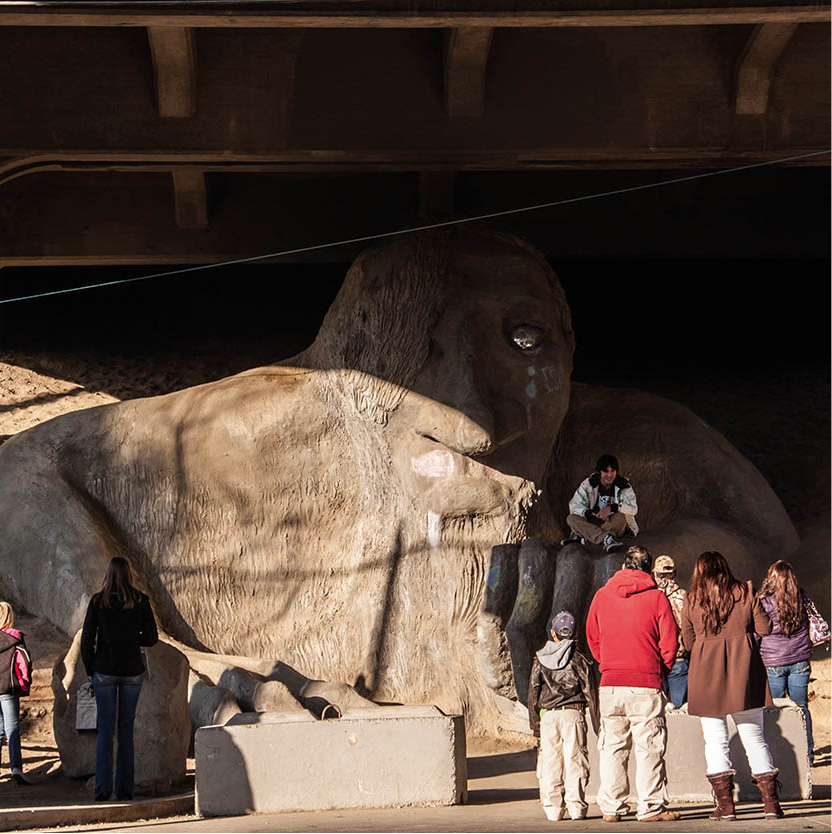
The ‘Troll Under the Bridge’ sculpture in Fremont.
nathaniel gonzales/APA publication
By the 1960s, hippies and unemployed drifters had taken over the Fremont and Triangle hotels, but the 1970s brought a long-awaited local renaissance. Artists moved into the cheap brick studios in lower Fremont, setting up the kind of eclectic galleries, shops, and cafés that define the neighborhood today. Fremont got funky. Longtime Seattleites, however, view the current ‘Fremont funkiness’ as a little forced. Countless condo projects, which followed the offices of companies like Adobe and Getty Images, pushed Fremont real estate values up, and pushed out many of the artists and other folks who gave the neighborhood its charm.
These days, its stores are likely to be chic boutiques rather than hippie havens, but they are individually owned and fun to visit.
Fremont’s tavern life has survived during these changes, and options have even expanded. Choices now range from a biker atmosphere to young adults on the prowl, to pubs serving microbrews and almost-nightly live music. Good restaurants dish up cuisine ranging from vegetarian fare to Asian, to Greek, to upscale fine dining.
Fremont in its Heyday
At the height of its counterculture days, Fremont renamed itself ‘The People’s Republic of Fremont’ and later gave itself the moniker ‘Center of the Universe.’ As if to prove the point, there’s a signpost at Fremont Avenue N and Fremont Place showing the distances from Fremont to far-flung places around the globe. A lingering element of those free-spirited days is the Fremont Solstice Parade and Street Fair, one of the most eagerly anticipated events on the Seattle calendar, which takes place on the weekend nearest the summer solstice. The local community turns up with extravagant costumes and ornate floats, and there is usually a naked contingent, often on bicycles.
Fremont is home to some of the city’s most beloved sculptures, including the Fremont Troll, an 18ft (5.5-meter) sculpture of a troll clutching a real Volkswagen beetle under the Aurora Bridge on Troll Avenue, and The Statue of Lenin, a 16ft (5-meter) bronze sculpture of Vladimir Lenin outside a gelato shop on the corner of Evanston Avenue and 36th Street. Waiting for the Interurban, on 34th Street, just north of the Aurora Bridge, features five life-size adults, a baby in arms, and a dog (said to have the face of a former mayor), all supposedly waiting for the electric trolley, which until the 1930s ran north to the town of Everett. All three sculptures are regularly decorated by the public, and Lenin is ceremoniously lit for the winter holidays.
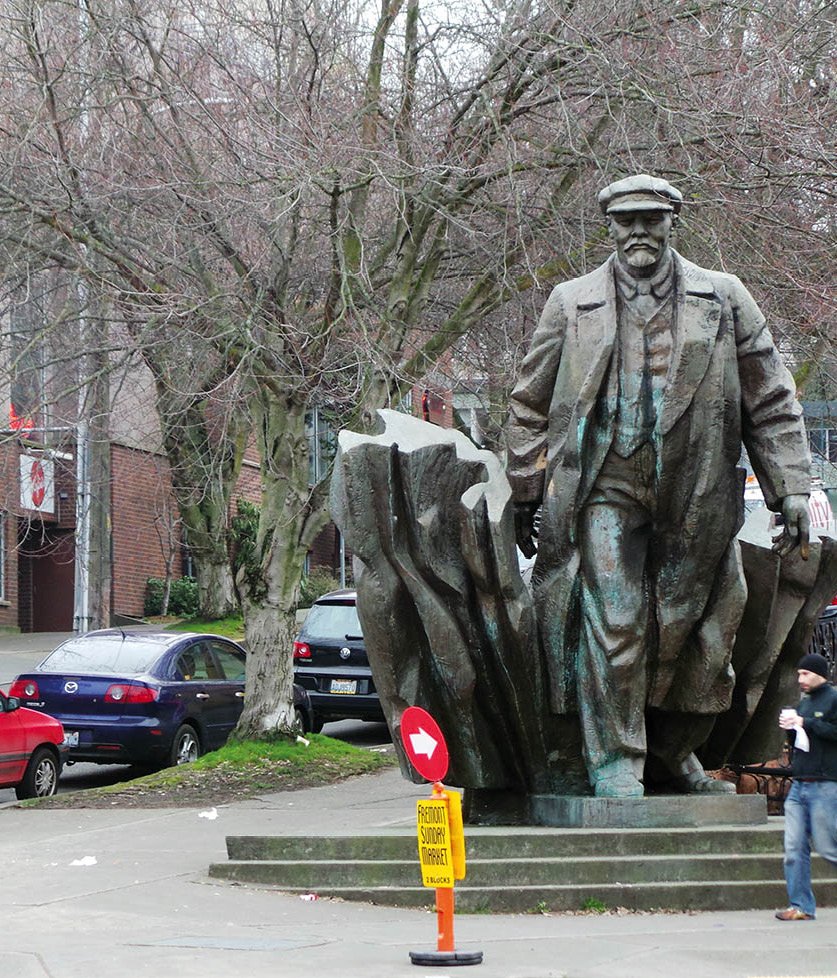
Statue of Lenin in Fremont.
nathaniel gonzales/APA publication
Green Lake, Phinney Ridge, and Greenwood
The shimmering waters of Green Lake @ [map] ripple against grassy shores in the high-density neighborhood of the same name.
It’s a lake in a city surrounded by water, an algae-tinged reservoir born of glacial gougings 15,000 years ago. Runners and inline-skaters zip along the busy 2.8-mile (5km) perimeter path in all weather. Rent a pair of blades or admire the occasionally aggressive ducks at the Waldo Waterfowl Sanctuary. Also keep a look out for great blue herons and an eagle.
A community center and its environs offer facilities including football fields, tennis courts, a swimming pool, gym, rowboat and canoe rentals, a large playground, and a beach. Restaurants around the lake range from trendy watering holes to fine Italian dining, to fish and chips.
Eat
The best coffeehouse around is Zoka (2200 N 56th Street, Green Lake). Open from 6am to midnight daily, Zoka roasts its own beans, serves yummy baked goods, and plays host to live music.
The neighborhoods of Phinney Ridge £ [map] and Greenwood $ [map] blend easily together. Greenwood Avenue, once touted as Seattle’s Antiques Row, mixes traditional antiques and secondhand stores with modern merchants and specialty food shops. There are galleries with contemporary Northwest art, home-style cafés, and several popular drinking establishments along the ridge.

A bird-trainer at Woodland Park Zoo.
nathaniel gonzales/APA publication
Address: 5500 Phinney Avenue N, www.zoo.org
Tel: 206-548 2500
Opening Hrs: May–Sept daily 9.30am–6pm, Oct–Apr daily 9.30am–4pm
Entrance Fee: charge
Transportation: bus 5
Almost 300 animal species inhabit the hills between Phinney Ridge and Green Lake at the Woodland Park Zoo % [map]. The former wilderness estate of Guy Phinney, a leading Seattle real-estate developer in the 1880s, this 92-acre (37-hectare) park pioneered the concept of creating naturalistic habitats for animals.
The zoo demonstrates a true commitment to cageless animal care. Eight bioclimatic zones provide comfort for the animals and encourage natural behavior. The Asian Elephant Forest and African Savannah have earned international recognition, and the Northern Trail area is a visitors’ favorite. Near the southeast exit, take time to smell the roses in the magnificent Seattle Rose Garden (free), originally laid out in the 1890s by old man Phinney himself.

Lion at Woodland Park Zoo.
nathaniel gonzales/APA publication
Along Lake Washington
On the southern stretch of the Sand Point peninsula, which juts out into Lake Washington north of the university, at least 87 species of birds and innumerable kinds of wildlife frequent the re-contoured terrain of Magnuson Park ^ [map], once a naval air station and now adorned with bluffs, sports fields, trails, and long, serene stretches of beach. On the same delta extending into Lake Washington, Bill Boeing flew his first airplane in 1916. In 1921, the first around-the-world flight began and ended here – four Navy aircraft left on April 6 and three arrived back on September 28.
In 1974, the city of Seattle granted the National Oceanic and Atmospheric Administration & [map] (NOAA) the northern 114 acres (46 hectares) of what had been the naval air station for NOAA’s Western Regional Center. It is now the largest federal center for atmospheric and oceanic research in the United States. Many of the facilities are open to the public through tours, but arrangements should be made first: National Weather Service (tel: 206-526 6087) and the Pacific Marine Environmental Lab (tel: 206-526 6239).
Monday through Friday from 9am to 5pm, walkers are invited to enter through NOAA’s main gate and stroll through an eerie and stunning Magnuson Sculpture Park featuring six pieces along a half-mile stretch of prairie. The artists combined earth, wind, and water among their media: a concrete spiraling dome gives views in every direction; a viewpoint over the lake with chairs and sofas is cut from boulders; a bridge is lettered with excerpts from Moby Dick; and a ‘sound garden’ of lacy towers and tuned organ pipes makes music from the wind – this beloved sculpture was the inspiration behind the band name Soundgarden.
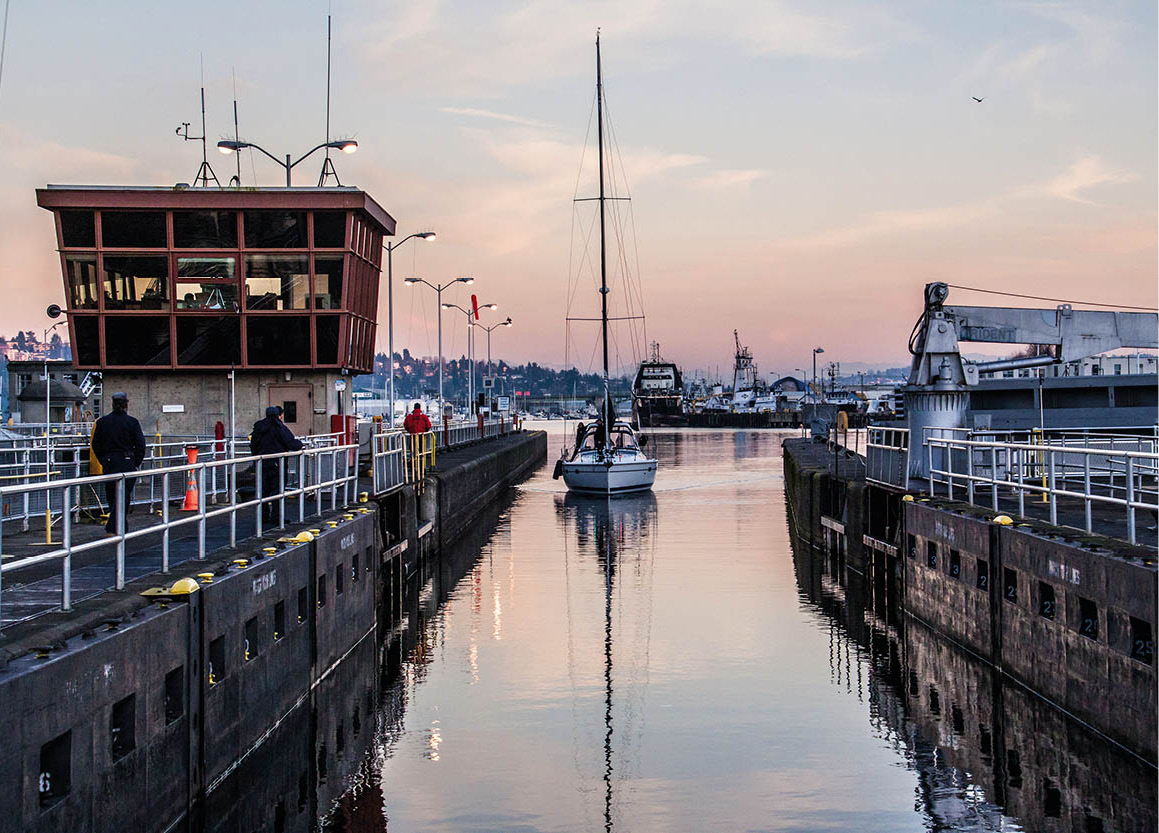
Sailboat preparing to dock at the canal.
Nathaniel Gonzales/APA Publication
About a mile to the north of Magnuson Park is Seattle’s largest freshwater bathing beach (a lifeguard is on duty) at Matthews Beach Park * [map], just off the Burke-Gilman Trail. At the south end, cross the footbridge above Thornton Creek to reach the tiny, charming Thornton Creek Natural Area, where wildlife finds a convenient retreat from the noisy, urban melee.
In the tiny hamlet of Pontiac, a railroad worker once hung a sign saying just ‘Lake’ on a shed near the tracks of Northern Pacific Railroad. The name stuck, and Lake City ( [map] was annexed by Seattle in 1954. Here, the blur of car lots, gas stations, and supermarkets lining Lake City Way may not make a huge impression, but the region has a few spots of distinction. A flagpole dedicated to World War II veterans sits in the smallest official city park, and a Will Rogers Memorial (12501 28th Avenue NE) honors the Oklahoma-born wit and philosopher, who spent one of his last days playing polo here. He then left Seattle for Alaska, and he was killed in a plane crash.
Eat
Heading west
If access to the jeweled shores of Puget Sound means prosperity, then Seattleites are rich indeed, for 220-acre (89-hectare) Carkeek Park ‚ [map], on the coast of Puget Sound and northwest of Green Lake, winds and plunges down into a maze of wooded pathways, over the railroad tracks, and onto an unfettered stretch of beach. The park was named for Morgan and Emily Carkeek, early Seattle contractors and philanthropists. Locals have successfully labored to re-establish the park’s Piper’s Creek as a salmon-spawning site.
Following the railroad tracks south leads toward the proud-hearted neighborhood of Ballard. The tracks run through Golden Gardens Park ⁄ [map] (on Seaview Place NW), neatly dividing it into two distinct sections: a forested hillside and a golden beach stretching along Shilshole Bay, Seattle’s coast of blue. Sunbathe, scuba dive, dig for clams, or watch the sailboats breezing out toward the Puget isles. Wind up Golden Gardens Drive and go south until a ‘scenic drive’ sign at NW 77th denotes the aptly named Sunset Hill.
Ballard ¤ [map]
Scandinavians were drawn here by the fishing, lumber, and boat-building opportunities found in such a majestic and watery region, much like their homeland. When downtown Seattle was rebuilt after the great fire of 1889 and Washington entered the Union as the 42nd state, Gilman Park, with nearly 2,000 residents, hurried to be the first to incorporate, naming their boomtown Ballard.
Early Ballard was a bastion of pioneer revelry, said to hold 27 saloons on a four-block strip. It has fewer today, but Ballard still sports its share of bars and plays a key role in Seattle’s music scene. It’s a fun neighborhood, with independently owned stores and businesses, a booming culinary scene, and a mix of fisherman and hipsters thronging the streets.
Nordic Heritage Museum ‹ [map]
Address: 3014 NW 67th Street, www.nordicmuseum.org
Tel: 206-789 5707
Opening Hrs: Tue–Sat 10am–4pm, Sun noon–4pm
Entrance Fee: charge
Transportation: bus 17
The exhibits at this heritage center tell a graphic story of Scandinavian immigrants’ travel to the new land and the impact those immigrants had on the Pacific Northwest. Three floors in a former elementary school describe the cultural legacy of Sweden, Norway, Iceland, Finland, and Denmark.

Fresh and salt water passing through the Hiram M. Chittenden Locks.
Nathaniel Gonzales/APA Publication
Address: 3015 NW 54th Street, www.nws.usace.army.mil
Tel: 206-783 7059
Opening Hrs: locks daily 7am–9pm; Visitor Center daily 10am–6pm, until 4pm in winter, closed Tue–Wed, Oct–Apr
Entrance Fee: free
Transportation: bus 17, 15, or 18
Every year, about 100,000 commercial and pleasure vessels navigate through the 1917-era Hiram M. Chittenden Locks › [map] – also known as the Ballard Locks – two masonry gates on the north bank of the canal and opposite Discovery Park, which raise and lower boats between the level of the saltwater of Puget Sound and the freshwater of Lake Washington. A fascinating Visitor Center explains the history and workings of the locks.
About 500,000 sockeye, chinook (king), and coho salmon use the same channel to get to their spawning grounds in Lake Washington and streams farther along in the Cascade Range to the east, climbing a 21-level fish ladder built to preserve the migrating runs. In summer, visitors can watch their passage upstream through six lit underwater viewing windows, a moving portrait of creatures driven by a mandate of nature and against all odds back to their birthplace.
Within the grounds are the terraced lawns and roses of the waterside Carl S. English Jr Ornamental Gardens fi [map]. Named after one of the region’s top horticulturalists in the early 1900s, the gardens make an excellent picnic spot.
